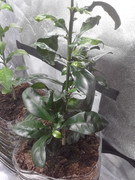476
Cold Hardy Citrus / Re: Flying Dragon Seedlings
« on: August 26, 2019, 02:47:48 AM »How fast does yuzu grow compared to Flying Dragon?Yuzu is fairly vigorous growing, yet maintains a moderately dwarfed growing habit.
The Internet's Finest Tropical Fruit Discussion Forum!
"All discussion content within the forum reflects the views of the individual participants and does not necessarily represent the views held by the Tropical Fruit Forum as an organization."
This section allows you to view all posts made by this member. Note that you can only see posts made in areas you currently have access to.
How fast does yuzu grow compared to Flying Dragon?Yuzu is fairly vigorous growing, yet maintains a moderately dwarfed growing habit.



How cold hardy Australian blood lime really is?I don't know, but I remember doing some research (reading around) in the past, and Australian Desert Lime has probably about the same level of hardiness as Satsuma mandarin (if not slightly more so).
US 852 (Changsha mandarin x trifoliate) seedlings. Which trifoliate did you use?Perhaps you misunderstand. The seedlings came from US 852.




Thank Socal for your confirmation, but on one of your old post stated that citrus rooted cutting is not as cold tolerant as one grown from seeds.I think you must have been misunderstanding what I stated.
many people claimed that citrus grown from seed is more cold tolerant than rooted cuttings. Isn't it true? Please confirm that for me.The only time grown from seed would make a difference is if the seedling happened to get a better mix of genes making it cold hardier than the parent (majority of the time not the case) or if not being a different variety from the roots would make a difference. Being grafted onto a different type of rootstock always creates some small degree of incompatibility, typically resulting in slower growth and smaller size. So the issue there would not really be whether it was grown from seed, but whether it was grafted onto different rootstock or was growing on its own roots.
I don't think Atlanta winter would be worst than the winter in Tibet.There are different elevations in Tibet. If Yuzu grows in that region, it would only be at the lower elevations. There are several different climate areas in Tibet, I don't think Yuzu would grow in the harsh climate area foreigners typically associate with Tibet.
Yes, but aren't they still considered a lemon. Didn't they all originate from the natural or artificial hybridization of the citron.No. Citron is a different species from Ichang papeda.